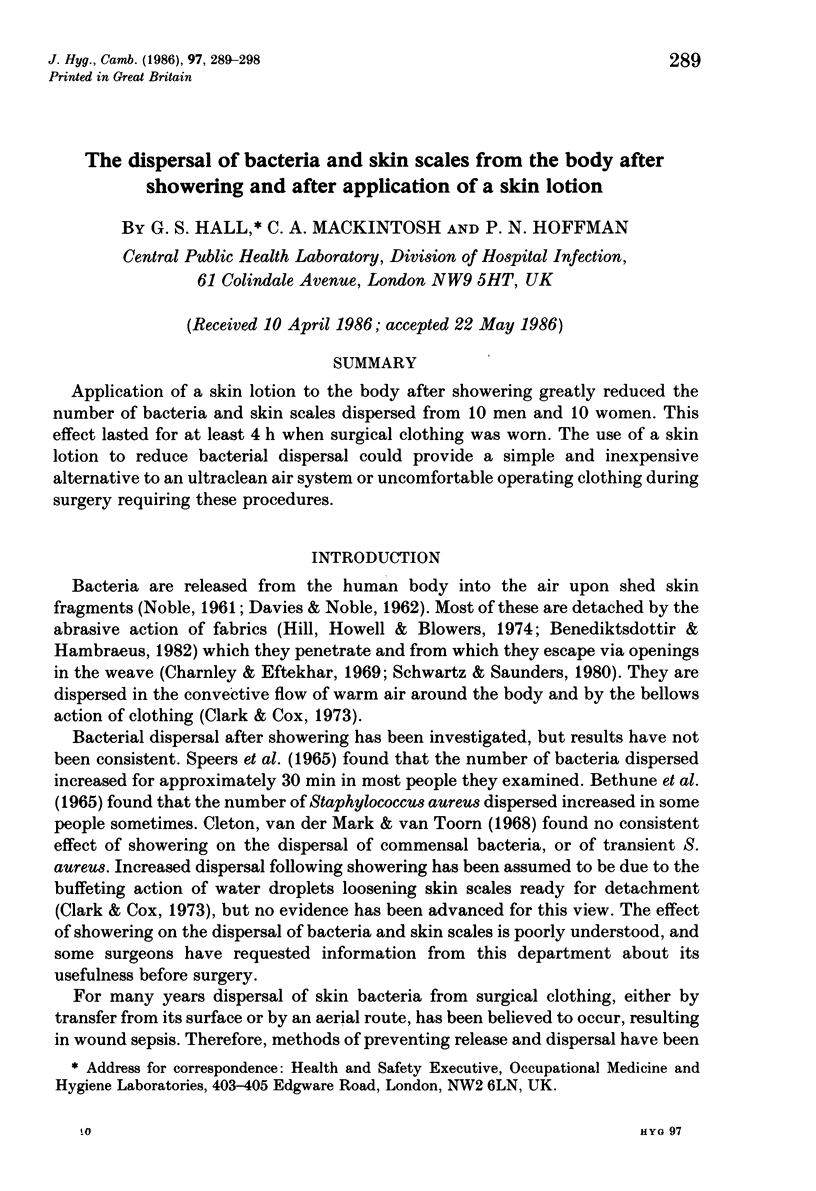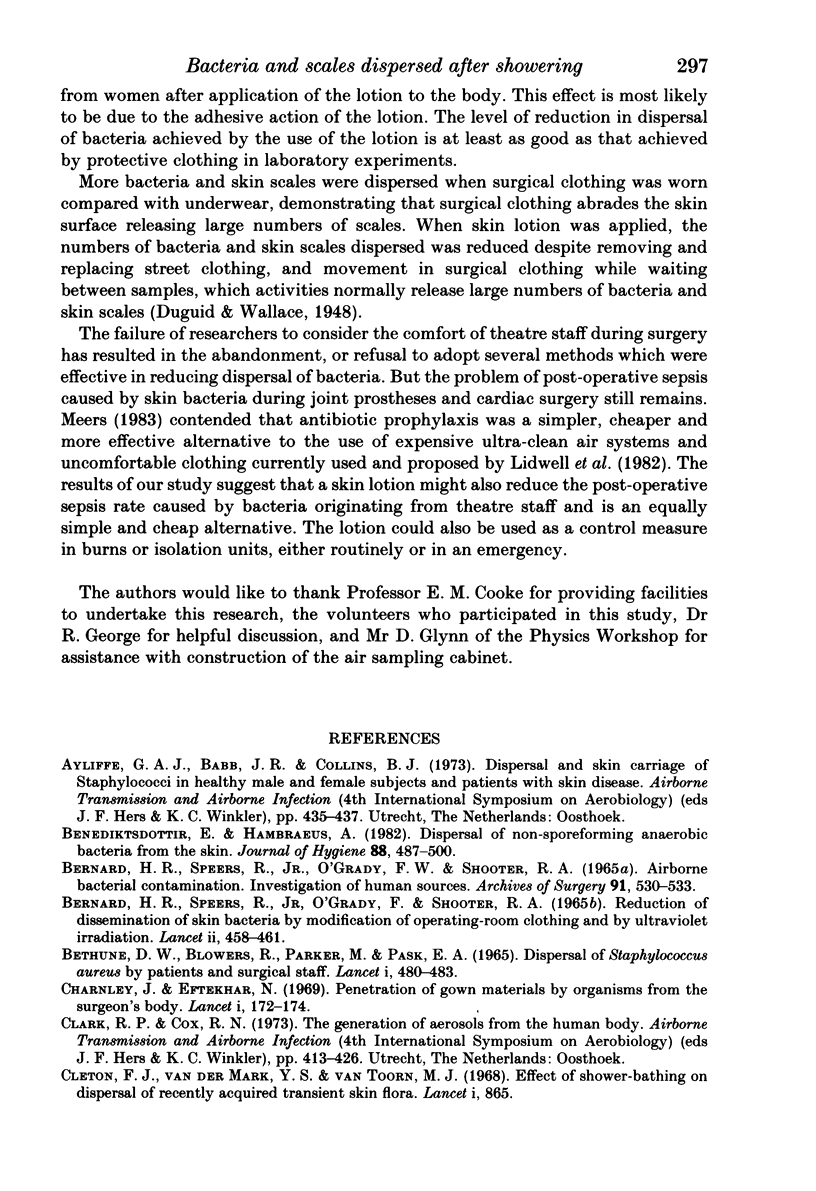Abstract
Application of a skin lotion to the body after showering greatly reduced the number of bacteria and skin scales dispersed from 10 men and 10 women. This effect lasted for at least 4 h when surgical clothing was worn. The use of a skin lotion to reduce bacterial dispersal could provide a simple and inexpensive alternative to an ultraclean air system or uncomfortable operating clothing during surgery requiring these procedures.
Full text
PDF









Selected References
These references are in PubMed. This may not be the complete list of references from this article.
- BERNARD H. R., SPEERS R., Jr, O'GRADY F. W., SHOOTER R. A. AIRBORNE BACTERIAL CONTAMINATION. INVESTIGATION OF HUMAN SOURCES. Arch Surg. 1965 Sep;91:530–533. doi: 10.1001/archsurg.1965.01320150160033. [DOI] [PubMed] [Google Scholar]
- BERNARD H. R., SPEERS R., Jr, O'GRADY F., SHOOTER R. A. REDUCTION OF DISSEMINATION OF SKIN BACTERIA BY MODIFICATION OF OPERATING-ROOM CLOTHING AND BY ULTRAVIOLET IRRADIATION. Lancet. 1965 Sep 4;2(7410):458–461. doi: 10.1016/s0140-6736(65)91421-2. [DOI] [PubMed] [Google Scholar]
- BETHUNE D. W., BLOWERS R., PARKER M., PASK E. A. DISPERSAL OF STAPHYLOCOCCUS AUREUS BY PATIENTS AND SURGICAL STAFF. Lancet. 1965 Feb 27;1(7383):480–483. doi: 10.1016/s0140-6736(65)91610-7. [DOI] [PubMed] [Google Scholar]
- Benediktsdóttir E., Hambraeus A. Dispersal of non-sporeforming anaerobic bacteria from the skin. J Hyg (Lond) 1982 Jun;88(3):487–500. doi: 10.1017/s0022172400070340. [DOI] [PMC free article] [PubMed] [Google Scholar]
- Charnley J., Eftekhar N. Penetration of gown material by organisms from the surgeon's body. Lancet. 1969 Jan 25;1(7587):172–173. doi: 10.1016/s0140-6736(69)91188-x. [DOI] [PubMed] [Google Scholar]
- Cleton F. J., van der Mark Y. S., van Toorn M. J. Effect of shower-bathing on dispersal of recently acquired transient skin flora. Lancet. 1968 Apr 20;1(7547):865–865. doi: 10.1016/s0140-6736(68)90334-6. [DOI] [PubMed] [Google Scholar]
- DAVIES R. R., NOBLE W. C. Dispersal of bacteria on desquamated skin. Lancet. 1962 Dec 22;2(7269):1295–1297. doi: 10.1016/s0140-6736(62)90849-8. [DOI] [PubMed] [Google Scholar]
- Evans C. A. Persistent individual differences in the bacterial flora of the skin of the forehead: numbers of propionibacteria. J Invest Dermatol. 1975 Jan;64(1):42–46. doi: 10.1111/1523-1747.ep12540897. [DOI] [PubMed] [Google Scholar]
- Hambraeus A., Ransjö U. Attempts to control clothes-borne infection in a burn unit. I. Experimental investigations of some clothes for barrier nursing. J Hyg (Lond) 1977 Oct;79(2):193–202. doi: 10.1017/s0022172400052992. [DOI] [PMC free article] [PubMed] [Google Scholar]
- Hill J., Howell A., Blowers R. Effect of clothing on dispersal of Staphylococcus aureus by males and females. Lancet. 1974 Nov 9;2(7889):1131–1133. doi: 10.1016/s0140-6736(74)90885-x. [DOI] [PubMed] [Google Scholar]
- Lidwell O. M., Lowbury E. J., Whyte W., Blowers R., Stanley S. J., Lowe D. Effect of ultraclean air in operating rooms on deep sepsis in the joint after total hip or knee replacement: a randomised study. Br Med J (Clin Res Ed) 1982 Jul 3;285(6334):10–14. doi: 10.1136/bmj.285.6334.10. [DOI] [PMC free article] [PubMed] [Google Scholar]
- Lidwell O. M., Mackintosh C. A., Towers A. G. The evaluation of fabrics in relation to their use as protective garments in nursing and surgery. II. Dispersal of skin organisms in a test chamber. J Hyg (Lond) 1978 Dec;81(3):453–469. doi: 10.1017/s002217240002533x. [DOI] [PMC free article] [PubMed] [Google Scholar]
- Matthews J., Slater K., Newsom S. W. The effect of surgical gowns made with barrier cloth on bacterial dispersal. J Hyg (Lond) 1985 Aug;95(1):123–130. doi: 10.1017/s0022172400062355. [DOI] [PMC free article] [PubMed] [Google Scholar]
- Meers P. D. Ventilation in operating rooms. Br Med J (Clin Res Ed) 1983 Jan 22;286(6361):244–245. doi: 10.1136/bmj.286.6361.244. [DOI] [PMC free article] [PubMed] [Google Scholar]
- Mitchell N. J., Evans D. S., Kerr A. Reduction of skin bacteria in theatre air with comfortable, non-woven disposable clothing for operating-theatre staff. Br Med J. 1978 Mar 18;1(6114):696–698. doi: 10.1136/bmj.1.6114.696. [DOI] [PMC free article] [PubMed] [Google Scholar]
- NOBLE W. C. The size distribution of airborne particles carrying Clostridium welchii. J Pathol Bacteriol. 1961 Apr;81:523–526. doi: 10.1002/path.1700810225. [DOI] [PubMed] [Google Scholar]
- Noble W. C., Habbema J. D., van Furth R., Smith I., de Raay C. Quantitative studies on the dispersal of skin bacteria into the air. J Med Microbiol. 1976 Feb;9(1):53–61. doi: 10.1099/00222615-9-1-53. [DOI] [PubMed] [Google Scholar]
- SPEERS R., Jr, BERNARD H., O'GRADY F., SHOOTER R. A. INCREASED DISPERSAL OF SKIN BACTERIA INTO THE AIR AFTER SHOWER-BATHS. Lancet. 1965 Feb 27;1(7383):478–480. doi: 10.1016/s0140-6736(65)91609-0. [DOI] [PubMed] [Google Scholar]
- Schwartz J. T., Saunders D. E. Microbial penetration of surgical gown materials. Surg Gynecol Obstet. 1980 Apr;150(4):507–512. [PubMed] [Google Scholar]
- Whyte W., Vesley D., Hodgson R. Bacterial dispersion in relation to operating room clothing. J Hyg (Lond) 1976 Jun;76(3):367–378. doi: 10.1017/s0022172400055297. [DOI] [PMC free article] [PubMed] [Google Scholar]
- Williamson P., Kligman A. M. A new method for the quantitative investigation of cutaneous bacteria. J Invest Dermatol. 1965 Dec;45(6):498–503. doi: 10.1038/jid.1965.164. [DOI] [PubMed] [Google Scholar]


